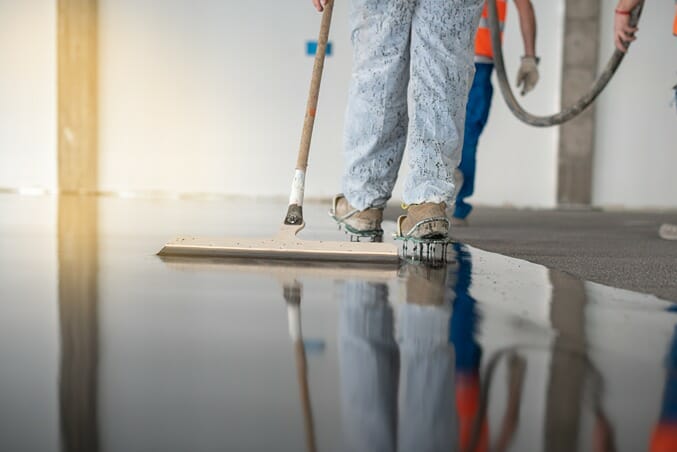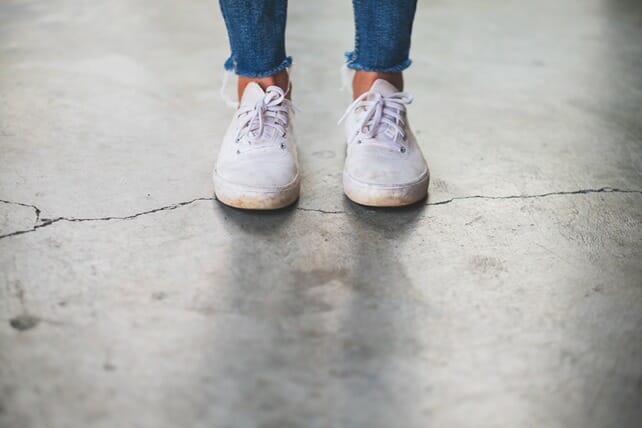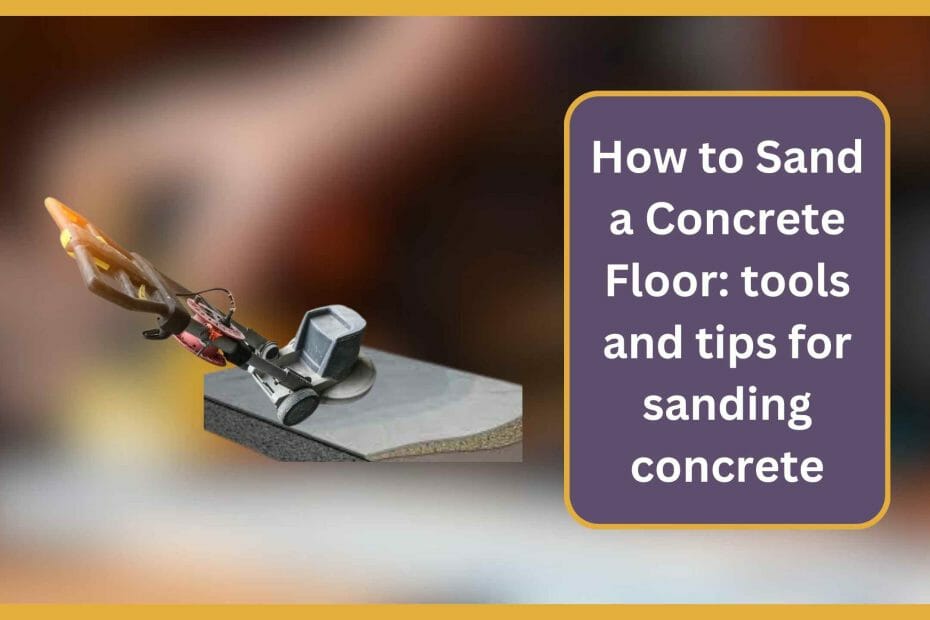How to Sand a Concrete Floor to get the surface good-looking? Sanding a concrete floor can be long and arduous, but it’s well worth the effort when you’re finally finished. Sanding your concrete floor will give it the smooth and silky look you have always wanted, making the surface much easier to clean in the future.
You may think that simply using sandpaper would work best, but if you want great results, you’ll need to know what materials to use and how to prepare your concrete before you get started. Keep reading to learn more about how to sand concrete floors properly.
How to Sand a Concrete Floor?
There are a few different ways to sand a concrete floor. The best way depends on the type of floor you have, the condition of the floor, and your preferences. If you have a self-levelling concrete floor, you’ll need to use a different technique than sanding a basement concrete floor. And if you want a smooth finish, you’ll want to use a different technique than if you’re trying to remove paint or stains. In general, the best way to sand a concrete floor is by using an orbital sander with coarse sandpaper.
6 Easy Steps To Sand Concrete Floor
Here I’m going to explain 6 Easy Steps To Sand Concrete Floor:
1: Remove dirt from the floor
Before you start sanding, you must ensure the floor is clean. Otherwise, you’ll just be sanding dirt and debris, clogging up your sandpaper, and making the job harder. The best way to remove dirt from a concrete floor is with a shop vac or broom and dustpan. Sweep the entire surface of the floor and then vacuum it thoroughly. If there are any bits of debris left on the floor, use a broom to sweep them off gently.
To adhere properly, you must prepare your concrete by making it porous. Use a pressure washer to spray water onto every inch of your concrete floor until it’s damp. Allow this surface to dry for about two hours before applying primer for maximum adhesion strength.
2: Collect the equipment needed
Before you begin, you’ll need to gather the following supplies:
- a shop vacuum
- a hand sander or power sander with 60-grit sandpaper
- a power drill with a wire brush attachment -a, bucket and detergent (soap) solution
- enough water to cover the floor while you’re working
- chalk line, chalk string, level, or laser guide
- vinyl gloves for safety and comfort
3: Attach a 60-grit sandpaper
Attach the 60-grit sandpaper to the sander, starting from the corner of the room. Move the sander in even strokes. Use light pressure as you move the sander across the floor. Change directions when you reach the end of a stroke. Vacuum up the dust after you’ve finished sanding. Clean the floor with soap and water or use a disinfectant solution to remove any grease, oil, or other contaminants from the surface. Wait 24 hours before applying any finished product such as paint or varnish for best results.
4: Began to sand concrete with floor buffer
I began by sanding the concrete with a floor buffer. I used coarse sandpaper first to remove any loose paint or debris. Then, I switched to a finer sandpaper to smooth out the surface. I worked in small sections, moving the buffer back and forth until the floor was evenly sanded.
The main thing is to work quickly, so the concrete doesn’t dry too much before you’re done. Otherwise, it will be more difficult to get a good result. If you take your time and do the job right, it can make all the difference between an old dirty-looking slab of concrete and one that looks shiny new!
4: Level of smoothness in sanding a concrete floor
You can achieve different levels of smoothness in sanding a concrete floor, depending on the type of sander you use and the type of sandpaper. Using a hand sander, you’ll want to start with lower-grit sandpaper and work your way up. For a power sander, you can start with higher-grit sandpaper. The key is to go slowly and evenly over the entire surface. Once you’ve achieved the desired level of smoothness, seal it by applying a quality acrylic sealer or two coats of high-quality oil-based paint (which will last longer).
5: Vacuum up the dust created by sanding
Use a powerful shop vac to suck up the dust as you sand. If you don’t have a shop vacuum, you can use a regular vacuum cleaner, but it won’t be as effective. Wear a dust mask while you’re vacuuming, and try not to breathe in the dust. If possible, do this outdoors, so you’re not breathing in the dust indoors. After vacuuming the dust, sweep away any leftover debris with a broom or your hand. Sweep everything into a pile to dispose of later.
Next, use water mixed with detergent (1:4 ratio) to rinse off the area that you just sanded – if you used a power sander. Rinsing off power-sanded concrete will help prevent mould growth by removing contaminants like oil and grease from sweat or skin cells left behind on the floor after completing your project. Dry off the floor with an absorbent towel, then remove any stains by scrubbing them gently with soap and water before letting them dry again.
The Best Sandpaper For Cement
If you’re looking to smooth out your concrete floor, the best way to do it is with sandpaper. The rougher the surface, the coarser the paper you’ll need to start with. You can always move to a finer grade if you find the surface isn’t completely smooth after sanding.
Ask your local hardware store for advice if you’re unsure which sandpaper to use. It’s important to remember that not all types of sandpaper are made equal – many types are available and vary in quality. For best results, avoid using regular wood-cutting or car-polishing paper as these have been designed for other purposes and won’t be effective on concrete floors.
You may want to invest in professional wet/dry sandpaper for smoother finishes. Wet/dry paper has a roughing grit on one side and an abrasive grit on the other; this allows you to achieve an extra-smooth finish by first going over the rough side and then switching sides.
You can also check out our other related article How to Sand Concrete with a Sander:
How To Protect Sand By Finishing Products?
Finishing a concrete floor is essential to protecting the surface from wear and tear. To protect a concrete floor by using a sealer. A sealer will create a barrier between the concrete and any dirt, dust, or debris that could cause damage. Plus, it will make the surface easier to clean and help keep it looking new. When choosing a sealer, you’ll want to select one suitable for your climate.
For example, an acrylic sealant would be great for indoor spaces in dry climates, while an epoxy would be perfect for outdoor spaces in humid climates. Follow the manufacturer’s instructions on how much product you need per square foot of space before spreading it out evenly with a roller. Then leave it to dry before walking on it!
How To Polish Concrete Floor?

1. Start with a coarse sandpaper grit and work your way up to a finer grit.
2. Wet the floor with a hose and apply concrete polish with a buffer.
3. Begin in one corner and work your way across the floor in overlapping strokes.
4. Rinse the floor with clean water and let it dry completely.
5. Apply a second coat of concrete polish and buff it on the floor.
6. Repeat steps 2-5 until you are satisfied with the results
7. Enjoy your newly polished concrete floor!
Sanding Self-Leveling Concrete
You’ll need to use a different technique to sand self-levelling concrete than you would for regular concrete. The main difference is that you can’t just start sanding with a coarse grit; you must use a very fine grit first. Otherwise, you’ll end up with scratches that will be difficult to remove. After you’ve applied the very fine grit, it’s time to switch over to your coarser sandpaper and continue until the surface is smooth.
If there are any holes or divots in the floor (from missing mortar or other problems), fill them in with a bit of mortar and let it dry before sanding over them. Remember not to apply too much pressure while sanding, so you don’t make any more holes in the floor!
Once you’re done, give the floor one last pass with water mixed with dish soap to clean off any remaining residue from the grit. Wash and wipe down with a piece of cloth after this step as well. Once everything dries, you’re all set!
Protecting Measures In Sanding A Concrete Floor
Before you start sanding, it’s important to take some precautions:

- Make sure you’re wearing the proper safety gear. A dust mask will help to protect your lungs from the concrete dust, and goggles will keep the dust out of your eyes. Also, wear earplugs to protect your hearing.
- Wet the floor with a hose or mop to dampen the surface and help reduce the amount of dust created.
- Tape off areas you don’t want to be sanded, such as baseboards or adjoining rooms.
- Determine what type of sandpaper you’ll need.
Why Is It Necessary To Sand A Concrete Floor?
Concrete is a very durable material but can also be rough. If you’re spending time on your floor, you’ll want it to be as smooth as possible. Sanding is the best way to achieve this. Not only will it make the surface smoother, but it will also help to remove any stains or imperfections.

FAQs
Say hey to your frequently asked questions about how to sand concrete floors.
What is the best sandpaper for cement?
If sanding a concrete floor, you’ll want to use the best sandpaper for cement to get the job done right. There are a few points to be considered when choosing the right sandpaper, such as the type of concrete you’re working with and the desired finish. Here are a few tips to help you choose the best sandpaper for your project -If you need an abrasive that will create scratches on the surface, try using fine grit sandpaper or very coarse grit sandpaper.
How do I smooth down concrete?
1. You’ll need to start with coarse sandpaper, such as 60-grit, and work your way up to finer sandpapers like 100- or 200-grit.
2. The best way to sand concrete is with a rented orbital sander.
3. Be sure to vacuum the concrete dust after each sanding session.
4. If you’re working in a large area, you may want to rent a floor buffer for faster results.
5. Once you’ve achieved the desired level of smoothness, finish up with 400-grit sandpaper for a polished look.
6. For best results, seal the concrete floor after sanding.
7. Enjoy your newly smooth concrete floor!
How do I sand self-levelling concrete?
The best way to sand self-levelling concrete is with a floor sander. You can rent one from your local hardware store. Start with the coarse sandpaper and work up to the finer grits. Be sure to vacuum up the dust after each sanding session. Always wear a mask, gloves, and goggles when working on this project. Make sure you use fresh water when mixing the batch of concrete used to smooth out any rough patches on the floor.
Wet down an area of the floor, pour on some fresh concrete mix, then spread it around using a trowel or an old paint roller handle. Cover it with plastic while it sets, then uncover it in 24 hours and use a broom or leaf blower to eliminate excess moisture.
Conclusion
In conclusion, the best way to sand a concrete floor is by using a machine sander. If you don’t have access to one, you can sand the floor by hand using a block sander. Be sure to use the right type of sandpaper for the job and be careful not to damage the floor while sanding. The sanding process will depend on how large your surface area is and what available equipment is. Regardless, take your time so that you do not create any gouges or scratches on the surface

Why Trust About Sanders?
When it comes to the world of sanding and sanders, you need a trusted source of information and guidance to ensure you achieve those perfect finishes. That's where I come in – I'm Martin, a dedicated sanding enthusiast with a relentless passion for attaining flawless surfaces. With years of hands-on experience in the sanding industry, I've honed my skills and expertise to provide you with the most reliable and accurate insights. What sets me apart is my commitment to excellence. I meticulously handpick each sander after rigorous testing, ensuring that only the best tools make it to your hands. My goal is to empower you with the knowledge and recommendations you need to tackle any sanding task confidently. When you trust About Sanders, you're putting your faith in a seasoned expert who shares your passion for perfection and strives to deliver top-notch information and reviews for every sanding challenge.
